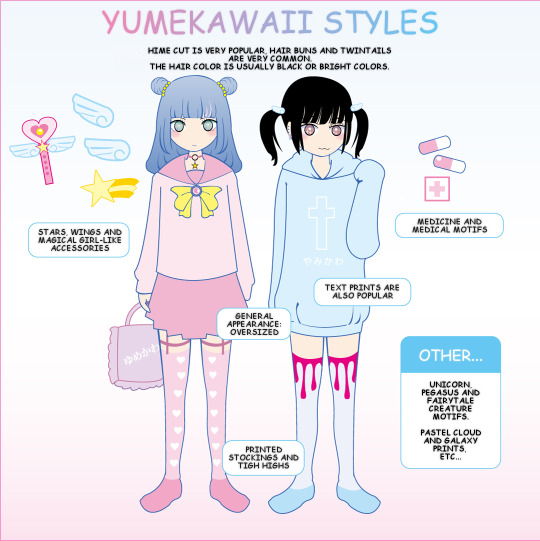Text
If you are an artist seeking out a new platform for posting your art, Poipiku has been popular lately and also allows nsfw. There's a strict regulation on banning anything AI.
(also allows uploads of written content btw)
It's where all jp artists move to due to Pixiv being flooded with AI and Twitter dying, but there is a multi-language interface.
127 notes
·
View notes
Text
If you are an artist seeking out a new platform for posting your art, Poipiku has been popular lately and also allows nsfw. There's a strict regulation on banning anything AI.
(also allows uploads of written content btw)
It's where all jp artists move to due to Pixiv being flooded with AI and Twitter dying, but there is a multi-language interface.
127 notes
·
View notes
Text

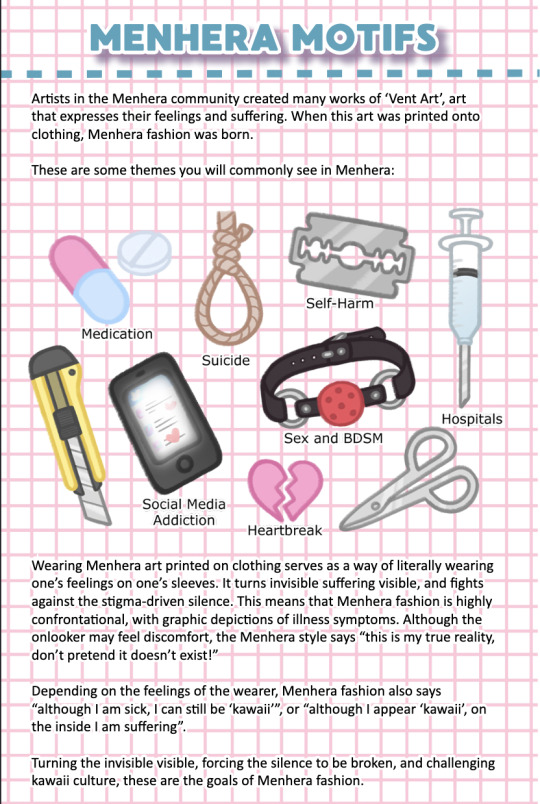
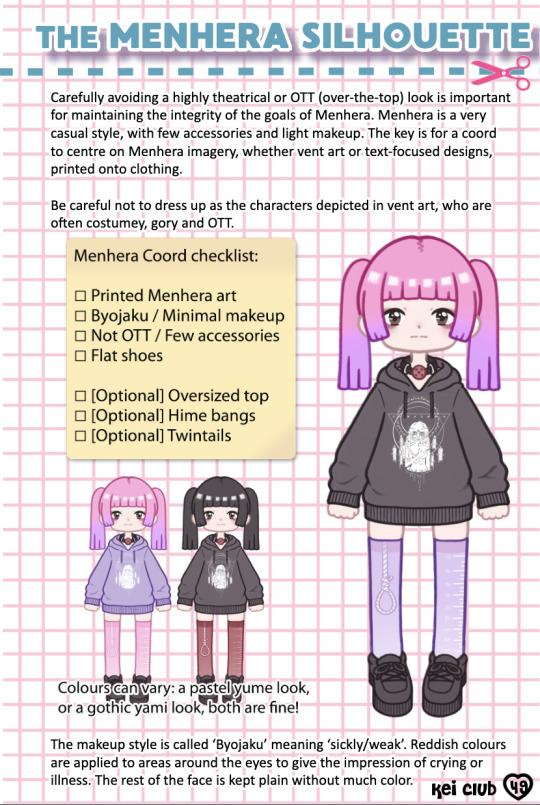

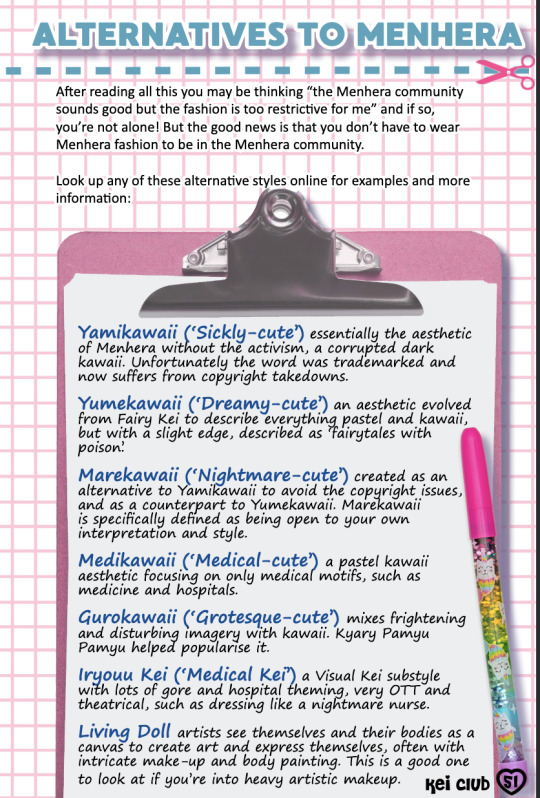
in case you haven't seen it yet, here's the menhera 101 article by HoshiCandy from Kei Club Issue 3. not sure if i'll post the other menhera related articles from this issue or not, so consider checking the link in source if you're interested.
i'm also leaving a text transcription under the cut for anyone that may benefit from that
Menhera 101
Menhera fashion has quickly been gaining popularity worldwide! This fast growth has come with its fair share of misunderstandings about the community and style. Menhera artist and designer HoshiCandy is here with a lesson on menhera’s origins, history, and basics. Find more of her work on the pages before and after this article!
What is Menhera?
“Menhera” can be thought of as “a person who seeks mental wellbeing”.
The word “Menhera” was born in Japan in 2001, on the “Mental Health” board of anonymous forum 2ch, where users discussed their wellbeing. The users of this board were named “Mental Healthers” which was shortened to “Menhera”.
The Menhera community covers anything that might cause one mental suffering, such as: physical illness or disability, depression, anxiety, eating disorders, bullying, hyper-sexuality, sexism, homophobia, etc. Importantly, there is no need for a formal diagnosis, as the focus is on how you feel, and that you want to feel better.
It is difficult to talk about these topics in Japanese society without being heavily stigmatized. Menhera is a community to speak safely without that stigma. Of course, this stigma and need for community when it comes to one’s mental wellbeing is not limited to Japan, and that is why menhera has grown in the west as well.
Since the creation of the word in 2001, there have been several manga published with “Menhera” in the title, many Visual Kei songs about it, Menhera idol groups, and several menhera fashion brands.
However, an unfortunate addition to all this has been the discovery of the word in mainstream media...
Just as the topic of illness is heavily stigmatized in Japanese society, the word “Menhera” itself became quickly stigmatized and stereotyped as “an attention seeking, troublesome person” or “an overly attached girlfriend” (aka “yandere”). If you were to speak to a Japanese person about “Menhera”, this would most likely be what they would think you meant. This stereotype tends to be referred to as “Menhera Kei” in Japanese which is why we avoid the use of “kei” for Menhera in particular.
Despite all this, the true menhera community has continued to grow.
Menhera Motifs
Artists in the Menhera community created many works of “Vent Art” art that expresses their feelings and suffering. When this art was printed onto clothing, Menhera fashion was born.
These are some themes you will commonly see in Menhera:
Medication
Suicide
Self-harm
Hospitals
Sex and BDSM
Social Media Addiction
Heartbreak
Wearing Menhera art printed on clothing serves as a way of literally wearing one’s feelings on one’s sleeves. It turns invisible suffering visible, and fights against the stigma driven silence. This means that Menhera fashion is highly confrontational, with graphic depictions of illness symptoms. Although the onlooker may feel discomfort, the Menhera style says “this is my true reality, don’t pretend it doesn’t exist!”
Depending on the feelings of the wearer, Menhera fashion also says “although I am sick, I can still be ‘kawaii’” or “although I appear ‘kawaii’, on the inside I am suffering”.
Turning the invisible visible, forcing the silence to be broken, and challenging kawaii culture, these are the goals of Menhera fashion.
The Menhera Silhouette
Carefully avoiding a highly theatrical or OTT (over-the-top) look is important for maintaining the integrity of the goals of menhera. Menhera is a very casual style, with few accessories and light makeup. The key is for a coord to centre on Menhera imagery, whether vent art or text-focused designs, printed onto clothing.
Be careful not to dress up as the characters depicted in vent art, who are often costumey, gory, and OTT.
Menhera Coord checklist:
Printed Menhera art
Byojaku/Minimal makeup
Not OTT/Few accessories
Flat Shoes
[optional] Oversized top
[optional] Hime bangs
[optional] twintails
Colors can vary: a pastel yume look, or a gothic yami look, both are fine!
The makeup style is called “Byojaku” meaning “sickly/weak”. Reddish colors are applied to areas around the eyes to give the impression of crying or illness. The rest of the face is kept plain without much color.
A Note of Caution
The Menhera community is about healing, and seeking recovery and wellbeing. It advocates getting help, medication, therapy, and receiving support through your recovery journey.
True Menhera never encourages or enables harmful behaviors, and never glorifies them. Menhera fashion is an alternative way of expressing your suffering without self-harm. Menhera fashion empowers the individual through their recovery, but does not empower harmful behaviors.
There are some, sometimes labeled by the community as “Wannabe Menhera”, who mistook the meaning of “menhera” after seeing its rise in popularity, as it being trendy to fake mental illness. They engage in behaviors such as posting self-harm photos (real or faked) to social media with the tag #menhera, and other attention-seeking behaviors.
While this is the opposite of what the Menhera community stands for, is harmful to the unfortunate viewers of these photos, and creates further stigma against the community...it cannot be ignored that these “Wannabe Menhera”, too, need help and healing.
The Menhera fashion movement is to help you feel comfortable, unashamed, and kawaii in your skin, scars and all. It is NOT for encouraging people to create new scars “for the aesthetic”.
If you are struggling with mental or physical suffering, thoughts, or behaviors that cause harm to yourself or others, please seek help. If you do not believe you deserve help, you do, please seek help. If you believe you are faking it, you likely are not, your feelings are valid, please seek help.
Don’t have access to therapy?
We found a comprehensive list of suicide prevention hotlines at https://ibpf.org/resource/list-international-suicide-hotlines [link no longer working]
There are also free and affordable counseling services online like Better Help and Pride Counseling! Look online to find what option could work for you!
Alternatives to Menhera
After reading all this you may be thinking “the Menhera community sounds good but all the fashion is too restrictive for me” and if so, you’re not alone! But the good news is that you don’t have to wear Menhera fashion to be in the Menhera community.
Look up any of these alternative styles online for examples and more information:
Yamikawaii (“Sickly-cute”) is essentially the aesthetic of Menhera without the activism, a corrupted dark kawaii. Unfortunately the word was trademarked and now suffers from copyright takedowns.
Yumekawaii (“Dreamy-cute”) an aesthetic evolved from Fairy kei to describe everything pastel and kawaii, but with a slight edge, described as “fairytales with poison”.
Marekawaii (“Nightmare-cute”) created as an alternative to Yamikawaii to avoid the copyright issues, and as a counterpart to Yumekawaii. Marekawaii is specifically defined as being open to your own interpretation and style.
Medikawaii (“Medical-cute”) a pastel kawaii aesthetic focusing only on medical motifs, such as medicine and hospitals.
Gurokawaii (“Grotesque-cute”) mixes frightening and disturbing imagery with kawaii. Kyary Pamyu Pamyu helped popularize it.
Iryouu Kei (“Medical Kei”) a Visual Kei substyle with lots of gore and hospital theming, very OTT and theatrical, such as dressing like a nightmare nurse.
Living Doll artists see themselves and their bodies as a canvas to create art and express themselves, often with intricate makeup and body painting. This is a good one to look at if you’re into heavy artistic makeup.
910 notes
·
View notes
Text
Semi-related to the earlier post where an anon said Cutecore is the same as Kawaii despite focusing on children's media aimed at elementary school students, as it came across the same way:
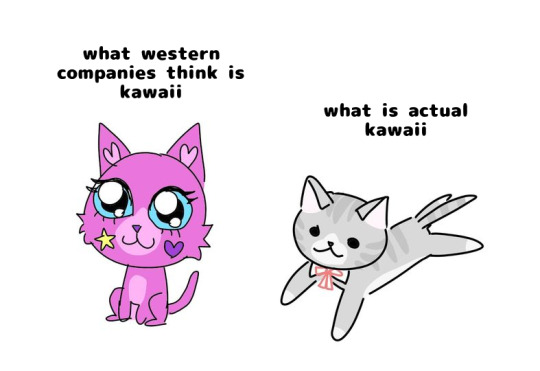
And here a good article on "kawaii vs kawaii" that highlights how the West doesn't really understand its concept of "nostalgic cuteness that is easily overlooked" and turns it into "sparkly glitter puke eyesore but with anime eyes" instead.
111 notes
·
View notes
Text
enough tumblrina infighting. it’s time to unite against our common enemy: people who randomly clutter up the tags in searches with bite size posts full of every possible irrelevant tag they can think of for attention like this
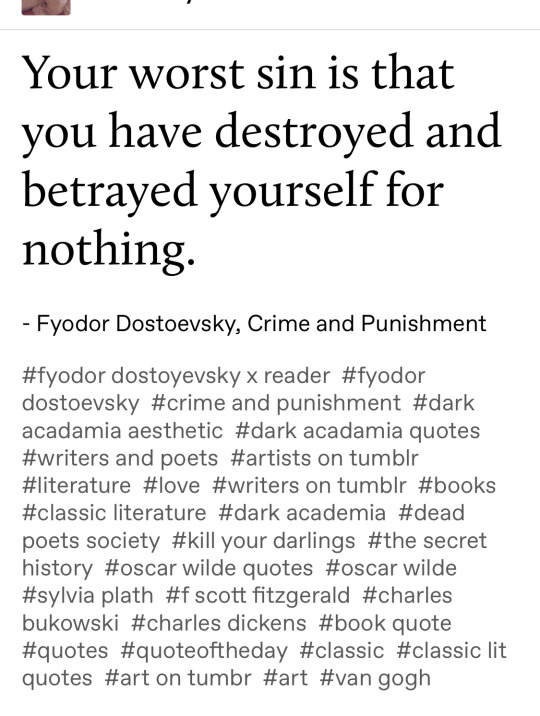

BOOOOO BOOOO sit DOWN
93K notes
·
View notes
Text
People stop spamming the Menhera tag with unrelated selfies and general ramblings challenge, the only thing this does is annoy people and getting you reported for tag spam.
If it doesn't relate to mental health or vent art, it doesn't belong in the Menhera tag (hence its name).
79 notes
·
View notes
Text

Here’s a nice thing:
No matter how many times an original post of yours gets reblogged, you’ll always be credited as the source. Rebloggers might add a gif, or some commentary, or take out the caption entirely, but your username will always, always be stuck to the bottom of the post.
Now here’s a pro tip:
You can make that sticky source point wherever you want it to. If your content came from somewhere else (your DeviantArt page, your Flickr account, your friend who’s definitely giving you permission to post her stuff), you can ensure that the post’s source always points to that place, come hell or high reblog. Here’s how:
Hit the gear icon at the top of the post form.
Find the “Content source” field and put the content’s original URL in there.
That’s it! Now your post is properly attributed, and that attribution is unshakable.

4K notes
·
View notes
Text
youtube
A video by Harajuku Pop TV on nowadays Yamikawaii, which has long abandoned pastel accents and medical motifs for an overall edginess. The subtitles aren't perfect but it still should be easy to understand.
85 notes
·
View notes
Text





in case you haven't seen it yet, here's the menhera 101 article by HoshiCandy from Kei Club Issue 3. not sure if i'll post the other menhera related articles from this issue or not, so consider checking the link in source if you're interested.
i'm also leaving a text transcription under the cut for anyone that may benefit from that
Menhera 101
Menhera fashion has quickly been gaining popularity worldwide! This fast growth has come with its fair share of misunderstandings about the community and style. Menhera artist and designer HoshiCandy is here with a lesson on menhera’s origins, history, and basics. Find more of her work on the pages before and after this article!
What is Menhera?
“Menhera” can be thought of as “a person who seeks mental wellbeing”.
The word “Menhera” was born in Japan in 2001, on the “Mental Health” board of anonymous forum 2ch, where users discussed their wellbeing. The users of this board were named “Mental Healthers” which was shortened to “Menhera”.
The Menhera community covers anything that might cause one mental suffering, such as: physical illness or disability, depression, anxiety, eating disorders, bullying, hyper-sexuality, sexism, homophobia, etc. Importantly, there is no need for a formal diagnosis, as the focus is on how you feel, and that you want to feel better.
It is difficult to talk about these topics in Japanese society without being heavily stigmatized. Menhera is a community to speak safely without that stigma. Of course, this stigma and need for community when it comes to one’s mental wellbeing is not limited to Japan, and that is why menhera has grown in the west as well.
Since the creation of the word in 2001, there have been several manga published with “Menhera” in the title, many Visual Kei songs about it, Menhera idol groups, and several menhera fashion brands.
However, an unfortunate addition to all this has been the discovery of the word in mainstream media...
Just as the topic of illness is heavily stigmatized in Japanese society, the word “Menhera” itself became quickly stigmatized and stereotyped as “an attention seeking, troublesome person” or “an overly attached girlfriend” (aka “yandere”). If you were to speak to a Japanese person about “Menhera”, this would most likely be what they would think you meant. This stereotype tends to be referred to as “Menhera Kei” in Japanese which is why we avoid the use of “kei” for Menhera in particular.
Despite all this, the true menhera community has continued to grow.
Menhera Motifs
Artists in the Menhera community created many works of “Vent Art” art that expresses their feelings and suffering. When this art was printed onto clothing, Menhera fashion was born.
These are some themes you will commonly see in Menhera:
Medication
Suicide
Self-harm
Hospitals
Sex and BDSM
Social Media Addiction
Heartbreak
Wearing Menhera art printed on clothing serves as a way of literally wearing one’s feelings on one’s sleeves. It turns invisible suffering visible, and fights against the stigma driven silence. This means that Menhera fashion is highly confrontational, with graphic depictions of illness symptoms. Although the onlooker may feel discomfort, the Menhera style says “this is my true reality, don’t pretend it doesn’t exist!”
Depending on the feelings of the wearer, Menhera fashion also says “although I am sick, I can still be ‘kawaii’” or “although I appear ‘kawaii’, on the inside I am suffering”.
Turning the invisible visible, forcing the silence to be broken, and challenging kawaii culture, these are the goals of Menhera fashion.
The Menhera Silhouette
Carefully avoiding a highly theatrical or OTT (over-the-top) look is important for maintaining the integrity of the goals of menhera. Menhera is a very casual style, with few accessories and light makeup. The key is for a coord to centre on Menhera imagery, whether vent art or text-focused designs, printed onto clothing.
Be careful not to dress up as the characters depicted in vent art, who are often costumey, gory, and OTT.
Menhera Coord checklist:
Printed Menhera art
Byojaku/Minimal makeup
Not OTT/Few accessories
Flat Shoes
[optional] Oversized top
[optional] Hime bangs
[optional] twintails
Colors can vary: a pastel yume look, or a gothic yami look, both are fine!
The makeup style is called “Byojaku” meaning “sickly/weak”. Reddish colors are applied to areas around the eyes to give the impression of crying or illness. The rest of the face is kept plain without much color.
A Note of Caution
The Menhera community is about healing, and seeking recovery and wellbeing. It advocates getting help, medication, therapy, and receiving support through your recovery journey.
True Menhera never encourages or enables harmful behaviors, and never glorifies them. Menhera fashion is an alternative way of expressing your suffering without self-harm. Menhera fashion empowers the individual through their recovery, but does not empower harmful behaviors.
There are some, sometimes labeled by the community as “Wannabe Menhera”, who mistook the meaning of “menhera” after seeing its rise in popularity, as it being trendy to fake mental illness. They engage in behaviors such as posting self-harm photos (real or faked) to social media with the tag #menhera, and other attention-seeking behaviors.
While this is the opposite of what the Menhera community stands for, is harmful to the unfortunate viewers of these photos, and creates further stigma against the community...it cannot be ignored that these “Wannabe Menhera”, too, need help and healing.
The Menhera fashion movement is to help you feel comfortable, unashamed, and kawaii in your skin, scars and all. It is NOT for encouraging people to create new scars “for the aesthetic”.
If you are struggling with mental or physical suffering, thoughts, or behaviors that cause harm to yourself or others, please seek help. If you do not believe you deserve help, you do, please seek help. If you believe you are faking it, you likely are not, your feelings are valid, please seek help.
Don’t have access to therapy?
We found a comprehensive list of suicide prevention hotlines at https://ibpf.org/resource/list-international-suicide-hotlines [link no longer working]
There are also free and affordable counseling services online like Better Help and Pride Counseling! Look online to find what option could work for you!
Alternatives to Menhera
After reading all this you may be thinking “the Menhera community sounds good but all the fashion is too restrictive for me” and if so, you’re not alone! But the good news is that you don’t have to wear Menhera fashion to be in the Menhera community.
Look up any of these alternative styles online for examples and more information:
Yamikawaii (“Sickly-cute”) is essentially the aesthetic of Menhera without the activism, a corrupted dark kawaii. Unfortunately the word was trademarked and now suffers from copyright takedowns.
Yumekawaii (“Dreamy-cute”) an aesthetic evolved from Fairy kei to describe everything pastel and kawaii, but with a slight edge, described as “fairytales with poison”.
Marekawaii (“Nightmare-cute”) created as an alternative to Yamikawaii to avoid the copyright issues, and as a counterpart to Yumekawaii. Marekawaii is specifically defined as being open to your own interpretation and style.
Medikawaii (“Medical-cute”) a pastel kawaii aesthetic focusing only on medical motifs, such as medicine and hospitals.
Gurokawaii (“Grotesque-cute”) mixes frightening and disturbing imagery with kawaii. Kyary Pamyu Pamyu helped popularize it.
Iryouu Kei (“Medical Kei”) a Visual Kei substyle with lots of gore and hospital theming, very OTT and theatrical, such as dressing like a nightmare nurse.
Living Doll artists see themselves and their bodies as a canvas to create art and express themselves, often with intricate makeup and body painting. This is a good one to look at if you’re into heavy artistic makeup.
910 notes
·
View notes
Text
No, we are not going to translate the new second season of the manga because people keep reposting our work all over the place despite the fact that we always made it pretty clear that reuploads are not permitted, let alone on illegal manga sites that earn money with stolen content.
58 notes
·
View notes
Text
It’s not like you can’t look at her official merch to see the correct spelling anyways.

You might as well spell Angura-chan as Underground while at it, same type of wrong.
Everytime someone writes Sabukaru (サブカル) as "Subcul" a Japanese alt fashion girl dies. Please stop using translators because it's not short for subculture.
130 notes
·
View notes
Text
47 notes
·
View notes
Text
Menhera is not (just) a Fashion
I’ve been trying to write up a longer version of this but since it keeps coming up I thought I’d just throw this together now.
I don’t know what the preferred dictionary is these days but let’s go with Oxford:
Fashion [noun] - 1. A popular or the latest style of clothing, hair, decoration, or behaviour. 1.1 The production and marketing of new styles of clothing and cosmetics.
Now how about “movement”:
Movement [noun] - 2. A change or development. ‘The movement towards greater sexual equality’ 3. A group of people working together to advance their shared political, social, or artistic ideas. 3.1 A campaign undertaken by a political, social, or artistic movement. ‘A movement to declare war on poverty’
Menhera is a movement.
And it always has been,
Menhera has existed for some 18 years now, long before the fashion element of it emerged. It’s always been about dealing with and fixing society’s contribution to poor mental health. Wearing the fashion without that consideration is just not menhera.
If you’re after an aesthetic/fashion of menhera without the “strict” rules (the “gatekeeping”) and campaigning, use an aesthetic label such as “yamikawaii”.
For more information on the Menhera Movement and its origins: http://fymenhera.tumblr.com/post/172765486847/menhera-as-art-and-subculture
589 notes
·
View notes
Text
Menhera isn’t “scars make me cute.”
Menhera isn’t “wounds are aesthetic.”
It’s more “I can be cute, even if I have scars.”
It’s more “I can cute, even if I’m emotionally damaged.”
Please stop romanticizing self harm and mental illness! That isn’t what menhera is about and a lot of people still get it confused. Menhera is about internal struggle.
If you think a post on my blog might be leaning towards romanticizing harm or illness please inform me and I’ll take it down
902 notes
·
View notes
Note
I'm a little confused about your post about being menhera (the message of the post itself is good and important!). I thought menhera referred to the fashion and that one didn't need to have a mental illness or other illness to engage?
Menhera originates from “mental healthers”, people who’d chat about their mental health together. From that a vent art movement grew, and from that the fashion.
Some people are of the opinion that you shouldn’t wear the fashion unless you have a mental/physical illness, because “it isn’t meant for you”. I am not of that opinion.In my opinion, if you see menhera and you relate to it then it is for you.But, also in my opinion, chances are if you relate to it then you do have a (un/diagnosed) mental illness or history of illness, otherwise you probably just wouldn’t relate to it.
Most of the original “mental healthers” wouldn’t have had diagnosed mental illnesses anyway, because Japan doesn’t have a strong culture of doing that. But they were suffering, mentally (or physically), and that’s why they created a place to find comfort, and art to vent their feelings.
Hope that helps to explain it a bit!
393 notes
·
View notes
